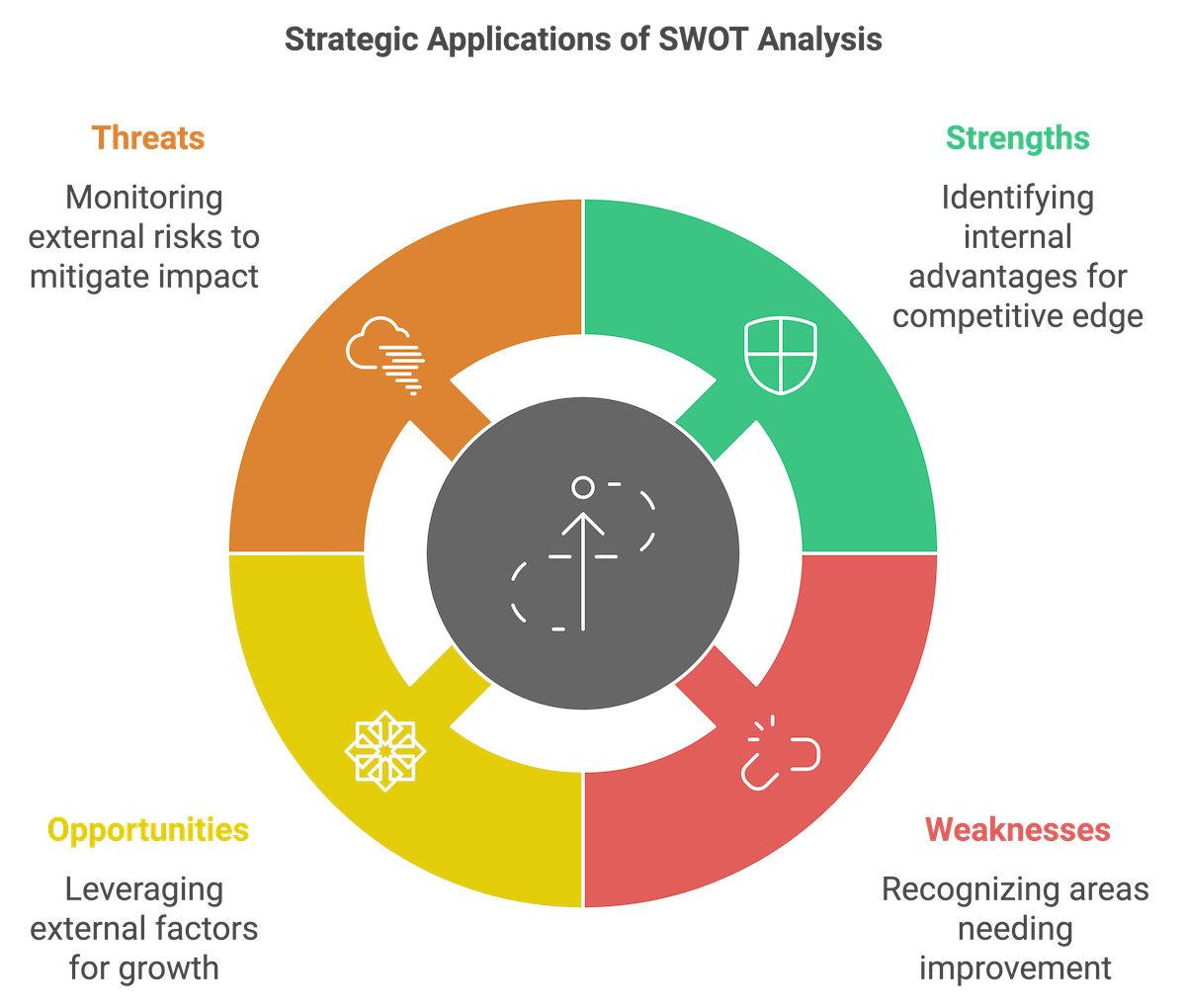SWOT Analysis: A Strategic Compass for Business Growth
By: Hayden Jarman

Every business wants a clear path to growth.
That’s why one tool remains essential: SWOT analysis. Conceived by Albert Humphrey and enhanced by Michael E. Porter and Henry Mintzberg, SWOT analysis is simple yet powerful. It's trusted by startups, enterprises, and educators alike.
Why?
SWOT analysis helps businesses uncover their strengths and weaknesses while spotting external opportunities and threats. This makes it indispensable for anyone aiming to stay ahead.
Let’s break down the fundamentals of SWOT analysis, see how digital tools amplify it, and explore why combining it with frameworks like PEST Analysis and Porter’s Five Forces provides a winning edge.
Table of Contents:
- Understanding the Fundamentals of SWOT Analysis
- Why SWOT Analysis Remains a Go-To Tool
- How to Conduct a SWOT Analysis Effectively
- Creating a Strategy with SWOT Insights
- Digital Tools Elevate SWOT Analysis
- SWOT Analysis for Digital Marketing Success
- Practical Applications of SWOT for Strategy Development
- The Value of Combining SWOT with Digital Marketing Strategies
- Final Thoughts
🧠 How Well Do You Know Your Weaknesses? Reflective Quiz 🕵️♂️
Answer these questions to gain insights into potential areas for improvement in your business.
Understanding the Fundamentals of SWOT Analysis
SWOT stands for Strengths, Weaknesses, Opportunities, and Threats.
It offers a complete view of where your business stands internally and how external factors might affect it. Whether it’s a small business or a global brand, every organization benefits from this structured approach.
Strengths: Your internal advantages.
Weaknesses: Areas needing improvement.
Opportunities: External factors to leverage for growth.
Threats: External risks to monitor and mitigate.
Example: A digital agency like BlueTone Media in Wilmington might list its strengths in SEO expertise and client-centric strategies, while recognizing the threat of Google’s frequent algorithm updates.
Table: SWOT Components Breakdown
| Component | Definition |
|---|---|
| Strengths | Internal attributes that give a competitive advantage |
| Weaknesses | Internal limitations affecting performance or growth |
| Opportunities | External factors that offer potential growth |
| Threats | External risks that could hinder success |
Why SWOT Analysis Remains a Go-To Tool
Its Universal Appeal and Utility
SWOT analysis works for a reason: it adapts to every industry and situation. Companies from McKinsey & Company to startups use it to guide major decisions.
Whether launching a new product, entering a new market, or refining SEO tactics, SWOT provides the insights to act strategically. It’s also widely taught in business schools, underscoring its importance in building a solid strategy foundation.
Learn More: Visit our guide on SEO for Multiple Locations to explore how this analysis can enhance multi-location strategies.
Combining SWOT with Other Frameworks
Modern businesses need multi-dimensional insights. That’s why many combine SWOT analysis with tools like PEST Analysis and Porter’s Five Forces.
PEST Analysis covers external macro-environmental factors (Political, Economic, Social, Technological), while Porter’s Five Forces evaluates competitive pressure in an industry. Integrating these frameworks gives a more complete view.
Table: Comparing SWOT, PEST, and Porter’s Five Forces
| Framework | Focus | Use Case |
|---|---|---|
| SWOT Analysis | Internal and external factors | High-level strategic planning |
| PEST Analysis | Macro-environmental influences | Understanding market conditions |
| Porter’s Five Forces | Industry competition and pressure | Assessing competitive dynamics |
How to Conduct a SWOT Analysis Effectively
Identifying Strengths
Start with your competitive edge. What does your business excel at? Strengths could be brand reputation, advanced technology, or a highly skilled team.
For BlueTone Media, a strong brand presence in Wilmington and expertise in content creation might top the list.
Analyzing Weaknesses
No business is perfect. Weaknesses are internal factors that limit growth, like skill gaps or outdated tech.
Recognizing these is crucial. If an agency lacks experience in newer Google algorithms, this could limit SEO performance.
Spotting Opportunities
Look for trends and technologies that open doors. In digital marketing, rising demand for Google My Business optimization is a prime example. For more, check out SEO for Service Businesses.
Examining Threats
Identify external risks that could disrupt your business. New competitors, regulatory shifts, or changes in Google’s algorithm are threats to monitor.
Creating a Strategy with SWOT Insights
Once you've gathered insights, it’s time to craft strategies based on your SWOT results.
Here’s how each element guides action:
- Leverage Strengths to maximize opportunities.
- Address Weaknesses to mitigate threats.
- Use Opportunities to counter weaknesses.
- Prepare Contingencies for external threats.
List: Strategic Actions Using SWOT
- Strengths: Capitalize on them to drive growth.
- Weaknesses: Turn them into learning and improvement areas.
- Opportunities: Integrate them into your action plan.
- Threats: Develop risk mitigation tactics.
Digital Tools Elevate SWOT Analysis
Digital tools now enhance how businesses use SWOT analysis. Real-time collaboration platforms, like Smartsheet, make it easier to create, update, and share SWOT matrices.
These tools streamline the process. They also support remote work, allowing teams to contribute from anywhere. By using real-time data, companies can back up their analysis with actual metrics, such as website analytics or Google Ads data.
Quick Fact: Companies adopting digital SWOT tools report a 25% increase in efficiency (Smartsheet).
SWOT Analysis for Digital Marketing Success
Strengths: Capabilities That Drive Success
Identify where your agency shines. For BlueTone Media, strengths might include a skilled team, cutting-edge design, and a comprehensive SEO strategy.
Weaknesses: Addressing Areas for Growth
In digital marketing, a potential weakness could be limited engagement on certain platforms. Or perhaps outdated SEO practices that haven’t been updated for Google’s 2024 ranking changes. See our SEO for Multiple Locations article for more.
Opportunities: Tapping Into New Trends
Growth often means recognizing emerging opportunities. For example, the rise of SEO-friendly web development has created demand for optimized websites, as explained in our SEO-Friendly Website Development guide.
Threats: Navigating Market Risks
External risks in digital marketing include algorithm changes and new competitors. The key is staying agile and ready to adapt to shifts in the industry.

Practical Applications of SWOT for Strategy Development
SWOT isn’t just about analysis; it’s about application.
Here’s a sample breakdown of how each component drives action:
- Capitalize on Strengths: Use team expertise to deliver impactful client campaigns.
- Address Weaknesses: Invest in advanced tools to keep up with algorithm updates.
- Leverage Opportunities: Expand service offerings in high-demand areas like local SEO.
- Mitigate Threats: Respond proactively to changes in Google’s algorithm to keep SEO strong.
The Value of Combining SWOT with Digital Marketing Strategies
SWOT analysis can enhance multiple areas of digital marketing. Whether it’s refining SEO, content creation, or social media strategies, this tool offers valuable insights.
For a digital agency, a SWOT might highlight a strong SEO background as a strength, while a weakness could be low engagement on emerging platforms. Recognizing these gaps helps in crafting focused strategies.
Integrating SWOT insights into digital strategies allows for a more comprehensive approach to driving growth. This holistic view not only guides day-to-day decisions but also supports long-term planning.
Final Thoughts
SWOT analysis remains essential for businesses seeking clarity and direction.
Its simplicity and adaptability make it a mainstay in strategic planning, even as digital tools and advanced frameworks emerge. By using SWOT, companies can make smarter decisions that keep them resilient, agile, and competitive.
For anyone serious about growth, this tool is invaluable. Start with a SWOT, layer on other frameworks if needed, and use the insights to drive strategic action.
Explore more on digital strategy and optimization with our guide to Schema Markup.
SWOT analysis may be timeless, but when combined with the right digital strategies, it becomes a dynamic force for growth and success.
Related Posts:
- Understanding Google’s Local Pack: How to Get Featured
- Google Business Profile FAQs: Everything You Need to Know
- The Best Google Ads Extensions to Boost Your Click-Through Rates
- How to Leverage Facebook Groups for Local Business Leads
- How to Use AI to Write Better Social Media Captions
- How to Optimize Google Reviews to Attract More Customers
- LinkedIn for B2B Marketing Success
- How to Conduct a Social Media Audit (w/ "Audit Readiness" Quiz!)
- Creating a Content Calendar for Consistent Posting
- The Importance of Mobile Optimization in 2024
- Data Privacy Regulations: What Marketers Need to Know
- The Role of Chatbots in Enhancing Customer Service
- SEO for Small Business: The Ultimate Guide to Getting Found Online
- The Role of Keyword Clustering in Modern SEO

